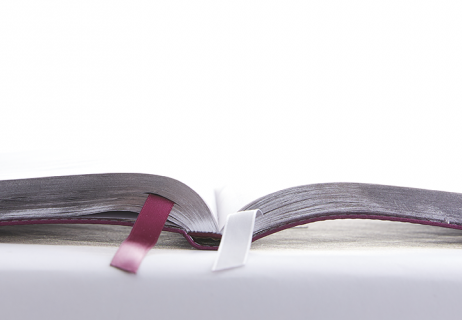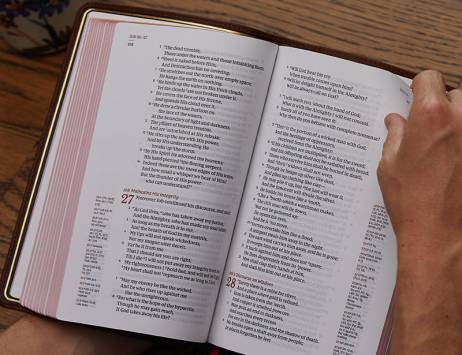Summary:
- Bible paper is important because of its role in durability and readability, so your Bible can withstand constant use over time.
- Bible paper can be thin to reduce bulk and weight, or strong and opaque, a symbolic reflection of the weighty significance contained in the Bible’s pages.
- Innovations in Bible printing technology enhance the physical connection to the Word, highlighting the resilience and lasting impact of high-quality Bible paper.
Paper is one of the most important features of a Bible. Legibility and usability are affected by the type of paper the text is printed on. Place the best tools and layout on paper that isn’t optimal and they can be difficult to use. This is why a lot of effort goes into choosing the right paper.
You may have heard terms like GSM, opacity, ghosting, acid-free, and line-matching in reference to Bible paper and design. In this article, we’ll discuss each of these terms, the types of Bible paper available, and see what paper is best for which types of Bibles.
What types of paper can you expect to find in various Bibles?
Not all Bible paper is the same. It comes in different levels of thickness and brightness, and each type is suitable for a different purpose. For example, we would need different paper in a Bible for notetaking than a Bible that’s made for carrying easily, or one made for preaching.
The paper has to be thin in order to fit over 700,000 words in a single volume in a manageable size. Study Bibles have a lot more words. The thickness of the paper is measured in GSM (Grams per Square Meter). The GSM affects how thick the Bible is, which is measured in PPI (Pages per Inch).
Unlike other books, which might be read one time, the paper in a Bible needs to be durable so that it can withstand being read multiple times for many years. Bible paper is a premium grade paper that’s made for heavy use.
In order to get the paper to be thin enough to keep the Bibles small and to keep the paper from discoloring over time, lignin (the cell structure in the wood pulp) is removed. Titanium dioxide is added to increase opacity, which also increases the cost. The amount of titanium dioxide will also affect the brightness and contrast of the paper.
When holding the paper to the light, you’ll see less light shine through and the paper will be consistent in its formation (uneven pulp fiber). It will look smooth instead of splotchy.
Bible paper is lightweight and there are several types, known by names such as Free Sheet, Bible paper, onionskin, and India paper. They have a high level of titanium dioxide to increase their brightness and opacity. They typically range between 25-40gsm.
Free Sheet is the most popular paper for Bibles. It’s sometimes referred to as India paper. India paper is typically 30gsm (20lb) or thinner.
In order to remain thin, the more expensive paper is coated so it doesn’t absorb moisture. It’s acid-free so it doesn’t change color over time.
Premium editions will have paper such as 36gsm European Bible paper that’s highly opaque and a joy to read, study, highlight, or preach from.
Journal editions often have thicker paper, usually around 38gsm, that’s made with writing in mind.
What’s the best Bible paper for notetaking?
Most Bibles are not made for notetaking. Most use lightweight paper to help keep their size and weight down. A lot of lightweight Bible paper can hold up to writing and highlighting, but the thinner the paper the more show-through it will have and the more likely it will damage the paper.
Paper for notetaking must be heavier than standard Bible paper in order to reduce show-through or even bleed-through of the inks and other creative mediums. A GSM of 36 or above is ideal for notetaking. This usually makes the Bible larger or reduces the number of tools in the Bible.
The Thomas Nelson journaling Bibles (NKJV and KJV Journal the Word) have 40gsm paper that’s made specifically for writing notes, thoughts, prayers, and artwork.
What’s the best Bible paper for preaching?
Paper for preaching needs to be easy to turn, have little show-through, have no glare under direct light, be optimal for reading with a good color and high contrast with the text, and be good for writing notes or highlighting.
The paper typically needs to be thicker than a standard Bible. It needs to be readable in low light, so the more contrast and opacity the better. It needs to be readable even if it’s sitting on the pulpit in front of you and it’s further away than you normally would read from.
The Thomas Nelson Preaching Bible (available in both KJV and NKJV) has 36gsm paper. This paper is great for preaching because it meets all of the above criteria.
What’s ghosting?
Ghosting, or show-through, is when the print on one side of the page can be seen on the other side. Show-through is different from bleed-through. With bleed-through the ink actually soaks through the page.
How well the print can be seen from the other side of the page will depend on the paper’s opacity. The more opaque the paper is the less transparent it is. Thick paper is usually more opaque than thin paper. Thin paper that’s highly opaque is often more expensive than thick paper with the same opacity.
Ghosting is expected on any thin paper, but the amount of show-through will depend on the type of paper the Bible has, which in turn is dependent on the purpose of the Bible.
The darker the font the higher the potential for show-through. To improve this, some publishers utilize a printing technique known as line-matching.
What’s line-matching?
Line-matching, also known as line-on-line, is the printing technique that matches the lines of the text to the same location on both sides of the page.
Line-matching helps eliminate the show-through even on thin paper. Since the text is printed in the same line on both sides, the text of the other side of the page isn’t noticeable except where the text isn’t printed (such as poetic settings). This still improves readability because you only read where the lines are printed.
Conclusion
There are lots of high-quality papers available for Bible production and they vary in opacity, brightness, and thickness. This is why two Bibles can look vastly different just in their paper alone. Some paper is better suited to one purpose over another. To get the most out of your Bible consider what you’re using it for and then look for a Bible with the paper that’s best suited for that purpose.





